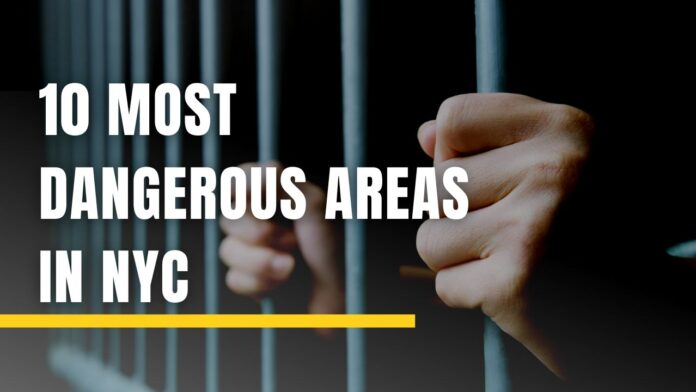New York City, often romanticized for its Broadway lights, towering skyscrapers, and cultural dynamism, has a contrasting side that’s less talked about: its dangerous neighborhoods. While NYC has made significant strides in improving public safety, certain areas remain plagued by high crime rates. This article takes a closer look at the most dangerous areas in NYC, highlighting crime trends, underlying causes, and ongoing efforts to improve security.
Understanding Crime in NYC
Over the past few decades, crime in NYC has declined dramatically thanks to law enforcement initiatives, community engagement, and urban development. However, this progress is not uniform across all boroughs. Pockets of the city still experience elevated crime rates due to factors like poverty, unemployment, gang violence, and lack of resources. Below, we analyze the 10 most dangerous areas in NYC, using recent crime statistics and real-world observations.
1. Brownsville, Brooklyn
Why It’s Dangerous:
- Violent crime rate significantly above the city average
- High gang activity
- Economic hardship and poverty
Crime Statistics:
- Population: 47,457
- Violent Crimes per 100k: 1,264
- Property Crimes per 100k: 1,546
Overview:
Brownsville continues to be one of NYC’s most crime-ridden neighborhoods. Despite several revitalization programs, gang violence, limited job opportunities, and a lack of social infrastructure contribute to ongoing safety concerns.
2. South Bronx (Mott Haven and Hunts Point)
Why It’s Dangerous:
- Longstanding economic challenges
- High rates of drug-related crimes
- Persistent gang presence
Crime Statistics:
- Mott Haven Violent Crimes per 100k: 2,039
- Hunts Point Violent Crimes per 100k: 1,944
Overview:
The South Bronx has seen slow improvements but still remains one of the most dangerous areas in NYC. Mott Haven and Hunts Point particularly struggle with theft, violent crime, and substance abuse issues.
3. East Harlem (Spanish Harlem)
Why It’s Dangerous:
- High violent crime rate
- Gang activity and drug trafficking
Crime Statistics:
- Population: 121,147
- Violent Crimes per 100k: 1,616
- Property Crimes per 100k: 2,938
Overview:
Rich in culture but burdened by crime, East Harlem faces challenges rooted in socio-economic inequality and a historical lack of investment in community services.
4. Bedford-Stuyvesant (Bed-Stuy), Brooklyn
Why It’s Dangerous:
- History of shootings and robberies
- Economic disparities
Crime Statistics:
- Population: 234,457
- Violent Crimes per 100k: 1,065
- Property Crimes per 100k: 1,837
Overview:
Bed-Stuy has undergone gentrification, but certain areas still deal with criminal elements and a lack of access to economic mobility.
5. Jamaica, Queens
Why It’s Dangerous:
- High property crime rate
- Issues with robbery and violence
Crime Statistics:
- Population: 131,773
- Violent Crimes per 100k: 874
- Property Crimes per 100k: 1,519
Overview:
Jamaica remains a crime hotspot, despite being a bustling hub of culture and commerce. Community policing and safety initiatives are currently in place to address these challenges.
6. East New York, Brooklyn
Why It’s Dangerous:
- Elevated violent and property crime rates
- Persistent economic stagnation
Crime Statistics:
- Population: 147,562
- Violent Crimes per 100k: 1,095
- Property Crimes per 100k: 2,176
Overview:
A historically underserved neighborhood, East New York struggles with poverty, crime, and a lack of job opportunities.
7. Fordham, Bronx
Why It’s Dangerous:
- Theft and property crime in commercial areas
Crime Statistics:
- Population: 48,002
- Violent Crimes per 100k: 1,238
- Property Crimes per 100k: 2,331
Overview:
Fordham’s mix of residential and commercial establishments makes it a target for theft and other crimes.
8. Canarsie, Brooklyn
Why It’s Dangerous:
- Previously high property crime and burglary rates
Crime Statistics:
- Population: 86,694
- Violent Crimes per 100k: 486
- Property Crimes per 100k: 1,385
Overview:
While showing signs of improvement, Canarsie still experiences challenges with safety, especially in less patrolled areas.
9. Tremont, Bronx
Why It’s Dangerous:
- High rates of property and violent crimes
Crime Statistics:
- Population: 55,743
- Violent Crimes per 100k: 1,233
- Property Crimes per 100k: 1,665
Overview:
Tremont has initiated several community-led safety programs, but crime remains a pressing concern for residents.
10. Rockaway, Queens
Why It’s Dangerous:
- Seasonal crime variations
- Property theft during off-peak months
Crime Statistics:
- Population: 119,512
- Violent Crimes per 100k: 795
- Property Crimes per 100k: 1,371
Overview:
Despite its scenic beaches, Rockaway’s crime rate spikes during the off-season when tourist numbers dwindle and policing decreases.
Contributing Factors to Crime in NYC
1. Economic Disparities: Neighborhoods with high poverty levels tend to have more crime due to limited access to education, jobs, and healthcare.
2. Gang Activity: Several of the most dangerous areas in NYC have active gang presences, often contributing to violent crimes and drug-related offenses.
3. Lack of Resources: Inadequate housing, underfunded schools, and limited community services exacerbate crime rates.
4. Policing and Public Trust: Mistrust in law enforcement and inconsistent policing further complicate crime prevention efforts.
What Is Being Done to Improve Safety?
1. Community Policing: NYPD has expanded programs that focus on building relationships between police and residents.
2. Youth Engagement: Initiatives like after-school programs and mentorship aim to steer young people away from crime.
3. Economic Investment: City efforts are underway to attract businesses and create job opportunities in high-crime areas.
4. Housing and Infrastructure: Revitalization projects aim to improve living conditions and reduce crime triggers.
Final Thoughts
While NYC continues to evolve, the challenges faced by its most dangerous areas should not be overlooked. These neighborhoods, rich in culture and community spirit, deserve targeted attention and sustainable development efforts. Through a combination of policy reform, community engagement, and economic investment, there’s hope for a safer, more equitable New York City.








